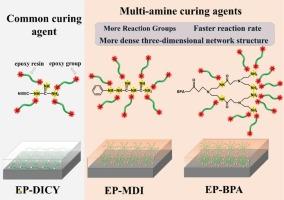Curing kinetics and performances of synthesized multi-amine compounds for epoxy powder coatings
IF 7.3
2区 材料科学
Q1 CHEMISTRY, APPLIED
引用次数: 0
Abstract
Amine compounds as a representative example of dicyandiamide (DICY) are one of the most important curing agents for epoxy powder coatings. In this study, two novel multi-amine compounds with more active groups, modified dicyandiamide (MDY) and branched polyamine (BPA), were synthesized and applied as the high-efficiency curing agents for epoxy powder coatings. The curing kinetics of two multi-amine compounds for epoxy powder coatings were investigated with the significant reduction of activation energy as 71.08 (MDY-cured system) and 65.44 kJ/mol (BPA-cured system) in comparison with the system cured by DICY (110.98 kJ/mol). The simulation of thermodynamic equation function curve revealed the considerable shortening of completely curing duration by about 40 min at T = 400 K for the multi-amine cured systems as the DICY-cured powder coating. In view of the storage stability and high-efficiency curing, the optimal ratio of two synthesized multi-amine curing agent for epoxy powder coatings was recommended as 1.2 of amino / epoxy groups in systems. However, the excessive MDY (such as 1.6 and 1.8 of amino / epoxy groups) added in the powder coatings will cause pinholes and reduced adhesion, although with an accelerated curing rate. The resultant coating films cured by two multi-amine agents at the optimal ratio exhibited higher Barcol hardness and impact resistance, as well as the improvement on acid resistance and salt water resistance, in comparison with the powder coating film cured by the traditional DICY.

合成的多胺类化合物在环氧粉末涂料中的固化动力学及性能
以双氰胺(DICY)为代表的胺类化合物是环氧粉末涂料中最重要的固化剂之一。合成了活性基团较多的改性双氰胺(MDY)和支链多胺(BPA)两种新型多胺化合物,并将其作为环氧粉末涂料的高效固化剂。研究了两种多胺类化合物在环氧粉末涂料中的固化动力学,与DICY固化体系(110.98 kJ/mol)相比,mdy固化体系和bpa固化体系的活化能分别为71.08和65.44 kJ/mol。热力学方程函数曲线的模拟表明,在T = 400 K时,多胺固化体系的完全固化时间明显缩短,约为40 min。考虑到环氧粉末涂料的储存稳定性和高效固化,推荐两种合成的多胺固化剂的最佳配比为体系中氨基/环氧基的比例为1.2。然而,在粉末涂料中添加过量的MDY(如1.6和1.8的氨基/环氧基)会导致针孔和附着力降低,尽管固化速度加快。两种多胺剂以最佳配比固化后的涂层与传统的DICY固化后的粉末涂层相比,具有更高的硬度和抗冲击性,耐酸性和耐盐水性。
本文章由计算机程序翻译,如有差异,请以英文原文为准。
求助全文
约1分钟内获得全文
求助全文
来源期刊

Progress in Organic Coatings
工程技术-材料科学:膜
CiteScore
11.40
自引率
15.20%
发文量
577
审稿时长
48 days
期刊介绍:
The aim of this international journal is to analyse and publicise the progress and current state of knowledge in the field of organic coatings and related materials. The Editors and the Editorial Board members will solicit both review and research papers from academic and industrial scientists who are actively engaged in research and development or, in the case of review papers, have extensive experience in the subject to be reviewed. Unsolicited manuscripts will be accepted if they meet the journal''s requirements. The journal publishes papers dealing with such subjects as:
• Chemical, physical and technological properties of organic coatings and related materials
• Problems and methods of preparation, manufacture and application of these materials
• Performance, testing and analysis.
 求助内容:
求助内容: 应助结果提醒方式:
应助结果提醒方式:


